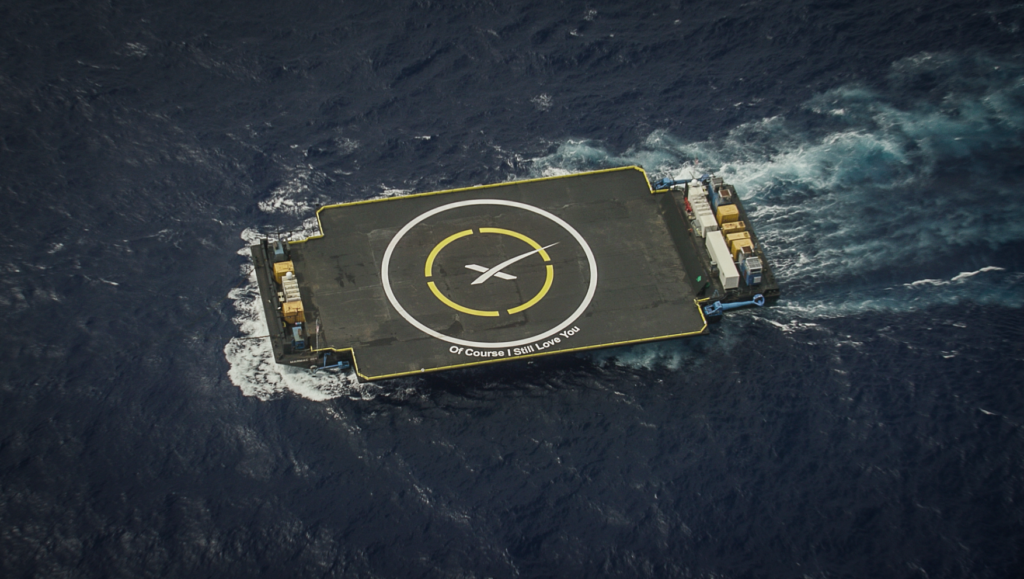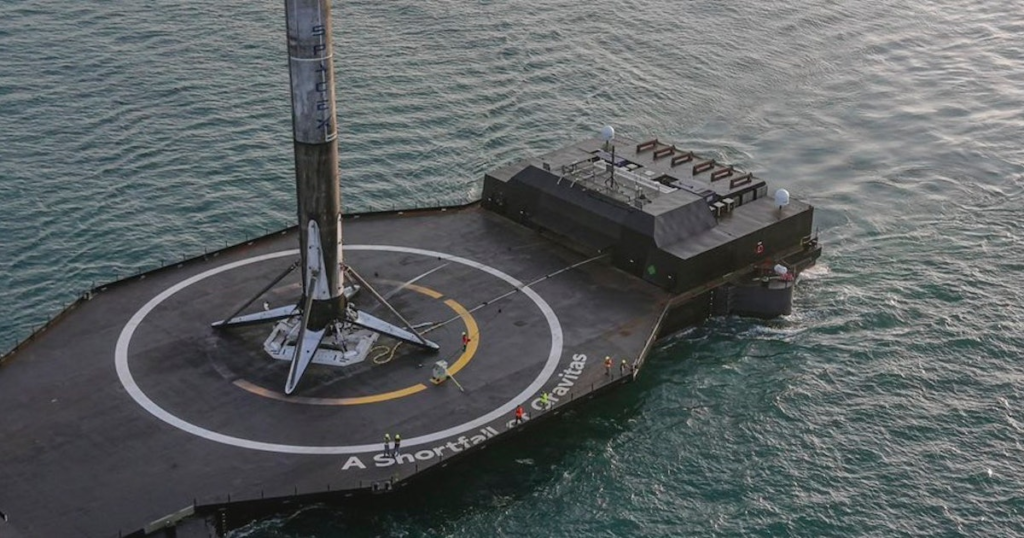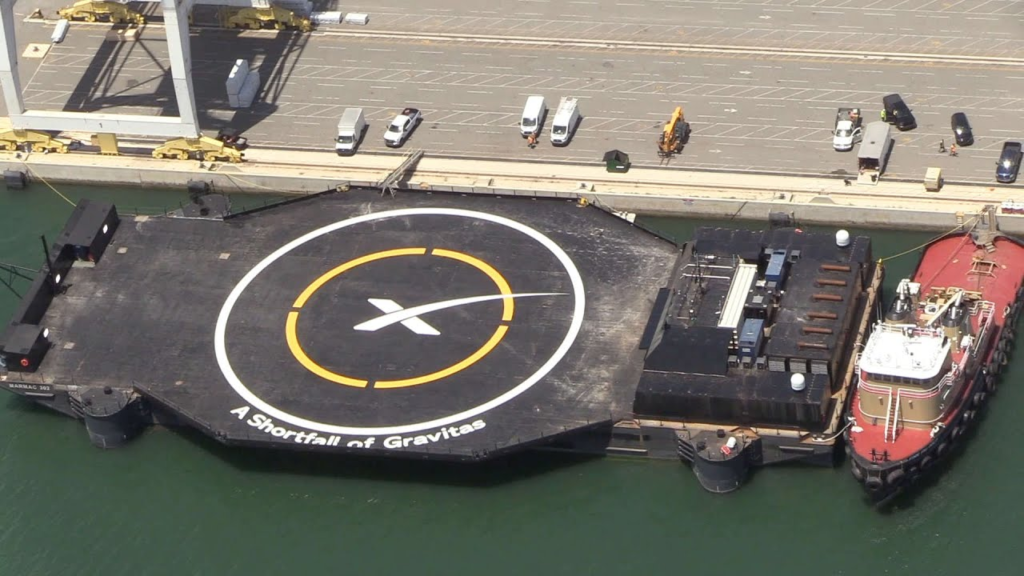
The Evolution of SpaceX’s Booster Recovery Droneships
For years, we have watched SpaceX land mainly Falcon 9 but also Falcon Heavy boosters on drone ships. So much so that today the process is not even considered a big deal to a lot of people because of how common its become. However, it wasn’t always like this, and in the time since SpaceX started operating these floating landing platforms, a lot has changed to improve the technology and make this process more viable.
Between improved communication, the Octagrabber, navigation system upgrades, and physical changes, the drone ships have been busy. At the same time, both the Falcon 9 and Heavy are launching more frequently than ever before. This combination is the backbone of current SpaceX reusability and helps the company cut down on costs and increase launch cadence.
Even with over 100 drone ship landings to date, new missions utilizing these landing platforms like never before are planned to happen. Here I will go more in-depth into the evolution of SpaceX’s drone ships, recent changes that effect their future, what to expect in the coming months, and more.
The Start of Droneships

Drone ships are a key component of SpaceX’s objective to significantly lower the price of space launch services through the “full and rapid reusability”, part of the rocket program. During any SpaceX launch, the company offers three options, depending on launch requirements: landing on land, landing at sea or expending the first stage, in order of increased performance and cost. Any Falcon flights launched into geostationary orbit or exceeding escape velocity require landing at sea, or expending the first stage. Less demanding launches from Florida can return to Landing Zones 1 and 2 at Cape Canaveral Space Force Station, while less demanding launches from California can return to Landing Zone 4. To put in perspective the importance of these floating landing platforms, around three quarters of recovered Falcon boosters land at sea as of 2022.
An autonomous spaceport drone ship (ASDS) is an ocean-going vessel derived from a deck barge, outfitted with station-keeping engines and a large landing platform, and is autonomously positioned when preparing for a landing. Currently, SpaceX has three operational drone ships including, Just Read the Instructions (II) (JRTI) and A Shortfall of Gravitas (ASOG), operating in the Atlantic for launches from Kennedy Space Center and Cape Canaveral Space Force Station, and Of Course I Still Love You (OCISLY), operating in the Pacific for supporting missions from Vandenberg Space Force Base.
In addition to these three drone ships that make up the SpaceX fleet, there is a fourth that hasn’t operated since the very beginning. Almost a decade ago in October 2014, SpaceX announced that they had contracted with a Louisiana shipyard to build a floating landing platform for reusable orbital launch vehicles. Early information indicated that the platform would carry an approximately 90 m × 50 m (300 ft × 160 ft) landing pad and would be capable of precision positioning so that the platform could hold its position for launch vehicle landing.
This initial drone ship was completed and soon named Just Read The Instructions. The landing location for the first landing test was in the Atlantic approximately 320 km (200 mi) northeast of the launch location at Cape Canaveral, and 266 km (165 mi) southeast of Charleston, South Carolina. However, in January 2015, during repairs to the ship following the unsuccessful first test, Musk announced that they were creating a sister ship planned for West Coast launches to be named Of Course I Still Love You (OCISLY). The first Just Read the Instructions had two landing attempts both of which were failures. It was eventually retired in May 2015 after approximately six months of service in the Atlantic Ocean, and its duties were assumed by Of Course I Still Love You. The former ASDS was modified by removing the wing extensions that had extended the barge surface and the equipment (thrusters, cameras, and communications gear) that had been added to refit it as an ASDS; these items were saved for future reuse.
Years later, Elon Musk announced plans for an additional barge, A Shortfall of Gravitas (ASOG), to support East Coast operations but the build of the droneship was delayed, and instead, JRTI was moved to the East Coast and began operations in June 2020.
By now Of Course I Still Love You has attempted 71 launches with a record of 63 successes and 8 failures. JRTI has had 51 successes and only a single failure, and ASOG has had 36 successes and not a single failure. Together these three modern drone ships have around a 95% overall success rate, which has only gone up over time.
Upgrades & Future

Normally, a tug is used to bring the drone ship to its oceanic position, and a support ship stands by some distance away from the crewless ASDS. Following landing, technicians and engineers typically board the landing platform and secure the rocket’s landing legs to lock the vehicle in place for transport back to port. The first stage is secured to the deck of the drone ship with steel hold-downs welded on to the feet of the landing legs. In June 2017, OCISLY started being deployed with a robot that drives under the rocket and grabs onto the hold-down clamps located on the outside of the Falcon 9’s structure after landing.
Starting with the A Shortfall of Gravitas and Just Read The Instructions after it, these drone ships will not need to use a tug to bring the ASDS to the Falcon 9 landing zone, as they will now be fully autonomous. Later, A Shortfall of Gravitas became the first ASDS that has an Automatic identification system (AIS) tracker, followed by another AIS tracker for Just Read The Instructions. This helps to track its voyage during recovery operations and especially when it becomes a fully autonomous droneship.
By June 2020, SpaceX had received the ability to use “its own private Automatic Identification System (AIS) aids to navigation (ATON) to mark the temporary exclusion areas it uses during rocket launches [from] Cape Canaveral, Florida”, the first such use of dynamic restricted area ever approved by the U.S. Coast Guard. In May 2023 SpaceX submitted an application to the FCC for a permit to land two Falcon Heavy side boosters on two droneship located downrange from Kennedy Space Center Launch Complex 39A. Specifically, Falcon heavy side boosters B1073, and B1076 are planning to land on two drone ships for the first time.
While these landing platforms may look simple on the surface, they are extremely innovative and complex pieces of technology. They rely on precision positioning, originally stated to be within 3 m (9.8 ft) even under storm conditions, using GPS position information and four diesel-powered azimuth thrusters. In addition to the autonomous operating mode, the ships may also be telerobotically controlled. The azimuth thrusters are hydraulic propulsion outdrive units with modular diesel-hydraulic-drive power units manufactured by Thrustmaster, a marine equipment manufacturer in Texas. The returning first stage must not only land within the confines of the deck surface, but must also deal with ocean swells and GPS errors.
SpaceX equips the ships with a variety of sensor and measurement technology to gather data on the booster returns and landing attempts, including commercial off the shelf GoPro cameras. At the center of the ASDS landing pads is a circle that encloses the SpaceX stylized “X” in an X-marks-the-spot landing point.
While drone ships have and will continue to provide SpaceX both cost and time savings, ideally, the company lands boosters on land. This process takes out different variables that often delay launches and also saves money. Recently with the Ax-2 launch, we saw the first attempt by the company to land a Falcon 9 booster on a crewed mission on land rather than a drone ship. To do this they used some of the margin left over to return to the launchpad. In the future, we can expect even more missions like this. At the same time, there will practically always be a place for drone ships on missions where the booster will not have the opportunity to get back to land even if it used every ounce of propellant.
Focusing on the future, SpaceX might not be the only company using drone ships. Last year reports came out that Blue Origin will use the same contractor as SpaceX did to modify a large drone ship for landing its New Glenn rocket’s first stage. This comes after the company scrapped its large cargo ship which was the original plan.
Specifically, In 2018 Blue Origin bought a former roll-on/roll-off cargo ship to be transformed into New Glenn’s future sea landing platform. Over the next couple of years, up until 2022, the ship had been in port undergoing a refit to prepare for a novel role of landing launch vehicle first stages. The idea being, the rocket boosters were planned to be recovered downrange of the Cape Canaveral Launch Complex 36 (LC-36) in the Atlantic Ocean while the hydrodynamically-stabilized ship was underway. The ship stabilization technology was intended to increase the likelihood of successful rocket recovery in rough seas, as well as help to carry out launches on schedule. However, in August of last year, Blue Origin abandoned its plans to use the ship as a landing platform, and the ship was towed to the Port of Brownsville for scrapping.
Conclusion
SpaceX has been using drone ships for years now with impressive results. As more and more Falcon 9 and Heavy rockets get scheduled to lift off, the drone ships are expected to play an even more important role. We will have to wait and see how it progresses and the impact it has on the space industry.
